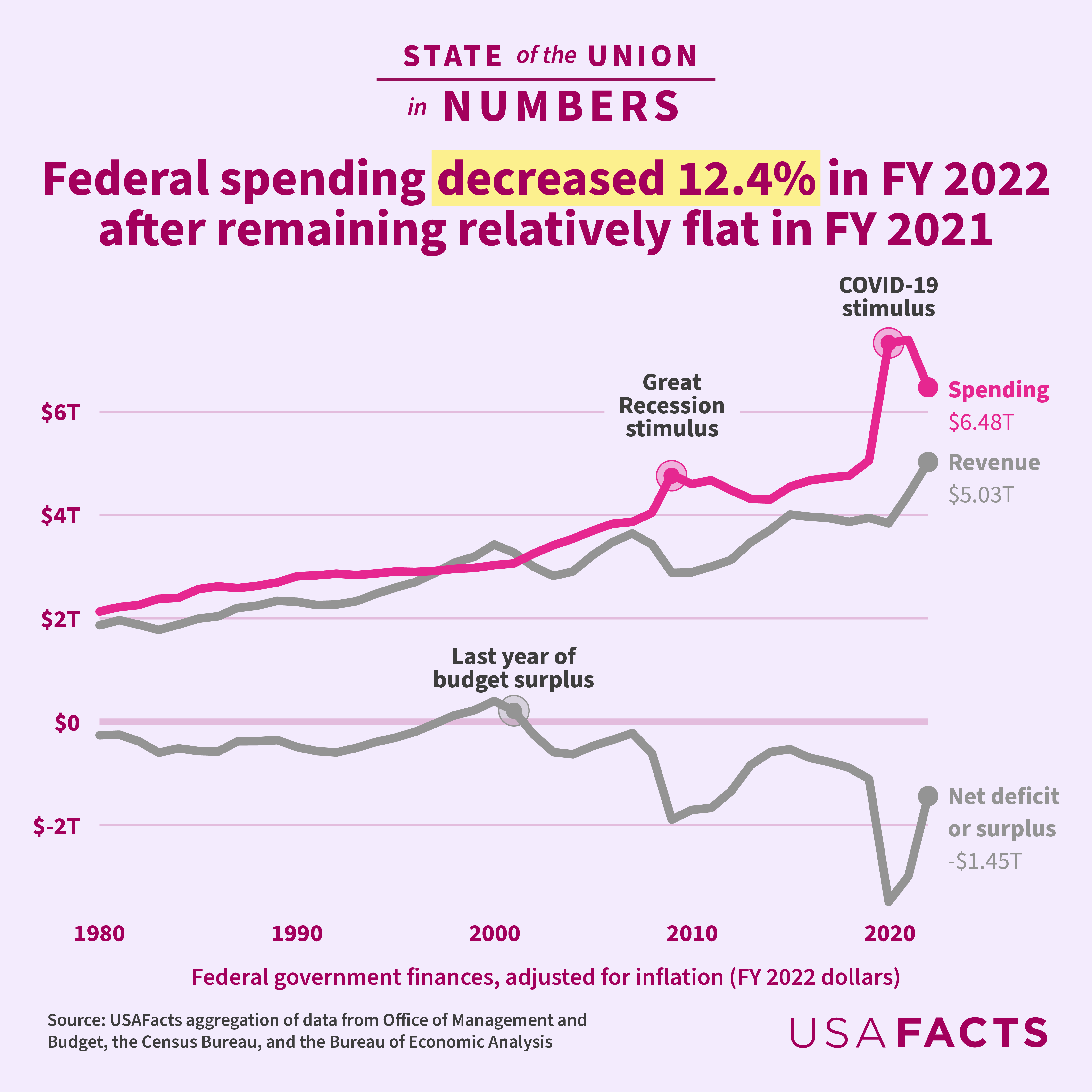The federal government spent $6.48 trillion in 2022, down $920 billion from the previous year after adjusting for inflation.
Spending per person totaled $19,434 per person, a 13% decrease from 2021. Expenditures were distributed across several major categories, with the largest going toward grants to state and local governments at $3,707 per person on average, and Social Security at $3,657 per person on average.
Using data from the State of the Union in Numbers, this chart visualizes how federal spending has grown over the past 40 years.

The previous fiscal year had the greatest decrease in federal expenditures since 1980, largely due to cutbacks in the government relief programs enacted during the pandemic.
It should be noted that these per person estimates don’t represent the US population as a whole. Large portions of federal expenditures are for Americans who require aid or assistance through social programs. Other people don’t require this assistance. Still, these averages provide an overall idea of how much the federal government spends per person.
Federal expenditures broken down per person
The federal government spent $19,434 per person, on average. This is more than double the amount spent on the average person in 1980 even after adjusting for inflation. Expenditures are broken up into different categories, such as:
- National defense and support for the veterans, including payments to the Departments of Defense and Veterans Affairs. In 2022, the government spent $3,094 per person on average toward this category, with $2,282 toward national defense, and $812 toward supporting veterans.
- Standard of living and aid to the disadvantaged, including expenses for toward cash and non-cash aid programs. Notably, this category includes the stimulus packages that were passed during the pandemic and granted to individuals. In 2022, the government spent an average of $1,858 per person in this category, with $991 toward aid to the disadvantaged, $395 toward the Supplemental Nutrition Assistance Program and similar programs, and the remaining $472 toward cash support programs, Earned Income Tax Credits, and unemployment insurance.
- Social Security, including payments to the national social insurance program, which helps Americans save for retirement and provide financial income for people with disabilities. In 2022, the government spent an average of $3,657 per person in this category, with $3,088 toward retirement funds.
- Medicare, including all funds granted to the nation’s federal health insurance program for people 65 or older, or those with certain disabilities and conditions. In 2022, the government spent an average of $2,269 per person here.
- Net interest on debt, which involves all funds allocated to paying off rising interest on the national debt. In 2022, the government spent an average of $1,451 per person in this category.
- Grants to state and local governments, including payments the federal government sets aside in its fiscal budget to help states and local governments fund a wide assortment of programs. In 2022, the government spent an average of $3,707 per person toward this category, with $1,450 toward Medicaid and the Children’s Health Insurance Program, $349 toward transportation services such as infrastructure, $238 for education services, $103 for child and social services, and the remaining $1,567 on other grants.
- Other spending includes public health and other miscellaneous programs. In 2022, the government spent an average of $3,400 per person here, with $1,609 toward education services, $424 toward public health services, and the remaining $1,367 on other public services.
The two spending hikes in 2009 and 2020 correspond to the Great Recession and the COVID-19 pandemic, respectively.
During these periods, the government allocated additional funding toward the standard of living and aid to the disadvantaged, state and local government grants, and other spending categories.
From the late 1980s to the late 1990s, the government allocated both a higher percentage and a greater amount of the budget toward paying off interest on the national debt. This, along with a rise in gross domestic product (GDP) would lead the US to a budget surplus from 1998 to 2001.
However, a combination of tax cuts, increased spending on national defense, and weak economic growth in the following years would return the federal government to a budget deficit in 2002. As of 2022, the US has continued to operate at a deficit every year.
The proportion of federal spending per person has changed over the past 40 years away from national defense and toward social programs.
Spending on national defense and support for veterans used to make up an average of 28.7% of federal expenditures during the 1980s, compared to an average of 18.6% between 2013 and 2022.
Per person Medicare spending has more than quadrupled since 1980, growing from 5% of the federal budget that year to 12% in 2022.
Federal funding is also distributed among various departments depending on the programs they oversee. Departments which administer the largest social programs, such as Medicare and Social Security, received most federal funding in 2022.
According to a 2022 report from the Government Accountability Office (GAO), spending on Social Security, Medicare/Medicaid, and net interest on debt is projected to outpace federal revenues by increasing amounts. The GAO considers this spending unsustainable long-term, and will require governmental action to avoid substantial debt.
To get a full picture of the US economy, read more about the debt ceiling and the national debt, and get the data directly in your inbox by signing up for our newsletter.
Keep exploring
Page sources and methodology
All of the data on the page was sourced directly from government agencies. The analysis and final review was performed by USAFacts.
USAFacts
State of the Union: Budget
US Treasury Department
How much has the U.S. government spent this year?